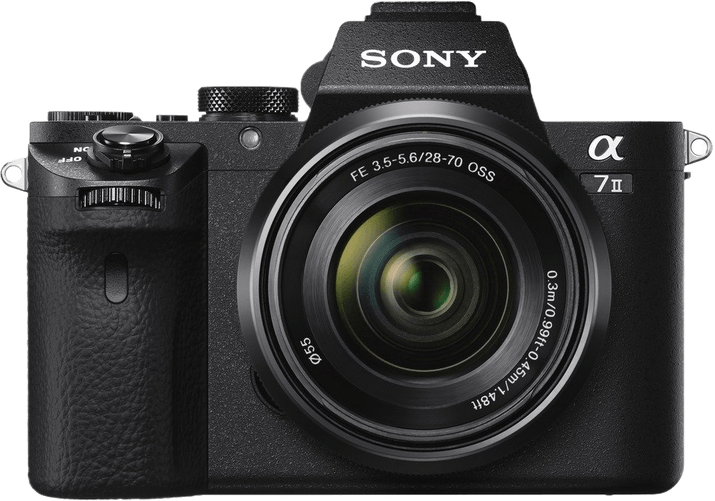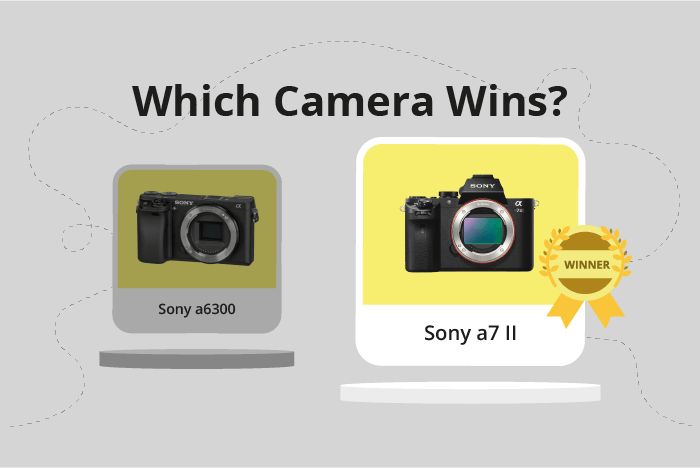Sony a6300 vs a7 II Comparison
Sony a6300

Sony a7 II

The Sony a7 II emerges as the winner with a score of 68/100, while the Sony a6300 scores 61/100. Both cameras are mirrorless and were released in 2014 and 2016, respectively. The a7 II has a higher launch price of $1600 compared to the a6300’s $1000.
In terms of size and weight, the Sony a6300 is smaller and lighter, measuring 120 x 67 x 49mm and weighing 404g. The Sony a7 II is slightly larger and heavier, at 127 x 96 x 60mm and 599g. This makes the a6300 more portable and travel-friendly.
However, the a7 II’s higher score suggests better overall performance and features, justifying its higher price. Both cameras have their advantages, with the a6300 being more compact and affordable, while the a7 II offers superior performance. Consider these factors when deciding on the right camera for your needs.
Sony a6300 vs a7 II Overview and Optics
The Sony a7 II takes the lead in optics with a score of 78/100, compared to the Sony a6300’s 68/100. Both cameras share similarities in specifications, such as having 24.2 megapixels, a CMOS sensor type, Bionz X processor, and Sony E lens mount.
The Sony a7 II outperforms the a6300 in several aspects. It has a higher DXOMARK score for the sensor at 90, as opposed to the a6300’s 85, indicating a superior image quality. Additionally, the a7 II boasts a full-frame sensor size, which provides better low-light performance and increased dynamic range. The a7 II also features image stabilization, ensuring sharper images and smoother video recording.
On the other hand, the Sony a6300 excels in shooting speed, capturing 11 frames per second, while the a7 II only reaches 5 frames per second. This makes the a6300 more suitable for fast-paced action and sports photography.
In terms of optics, the Sony a7 II emerges as the winner due to its higher sensor score, full-frame sensor size, and image stabilization. These features contribute to superior image quality and performance. However, the Sony a6300’s faster shooting speed makes it a strong contender for those who prioritize capturing fast-moving subjects. Ultimately, the choice between these two cameras depends on the specific needs and preferences of the photographer.
Sony a6300 vs a7 II Video Performance
The Sony a6300 outperforms the Sony a7 II in video capabilities with a score of 91 over the latter’s 56. Both cameras share some common features in their video specifications. However, the a6300 has superior video quality and additional features that make it the better choice for videography.
One of the key advantages of the Sony a6300 is its maximum video resolution of 4K (3840 x 2160), while the Sony a7 II offers only Full HD (1920 x 1080) resolution. This difference results in the a6300 providing sharper and more detailed video footage compared to its counterpart. Additionally, the a6300 boasts a higher maximum video frame rate of 120fps, as opposed to the a7 II’s 60fps. This allows for smoother slow-motion video capture and more flexibility during post-production.
Another significant advantage of the a6300 is its built-in time-lapse functionality, which is absent in the a7 II. This feature enables users to create stunning time-lapse videos without the need for additional equipment or software.
On the other hand, the Sony a7 II does not offer any specific advantages in video capabilities over the a6300. Its lower score reflects the lack of features and lower video quality compared to the a6300.
Considering these differences, the Sony a6300 is the better choice for those prioritizing video capabilities. Its superior video resolution, higher frame rate, and built-in time-lapse functionality make it a more versatile and powerful option for videographers. The Sony a7 II, while still a capable camera, falls short in these aspects, making the a6300 the clear winner in this comparison.
Sony a6300 vs a7 II Features and Benefits
The Sony a7 II wins in the features category with a score of 57/100, while the Sony a6300 scores 54/100. Both cameras share some common specifications, such as a 3-inch screen size, the absence of a touchscreen, a flip screen, no GPS, WIFI functionality, and no Bluetooth.
The Sony a7 II surpasses the a6300 with a higher screen resolution of 1,230,000 dots, compared to the a6300’s 921,600 dots. This higher resolution provides a clearer and sharper display, allowing users to better review their photos and navigate the camera’s menu.
However, the Sony a6300 does not fall short in every aspect. Although both cameras lack a touchscreen, the a6300 still offers excellent features, with only a slight disadvantage in screen resolution. The difference of three points in the features score is not substantial and does not significantly impact the overall performance of the a6300.
Both the Sony a7 II and the Sony a6300 have their strengths and weaknesses. The a7 II’s higher screen resolution is an advantage, but the a6300 remains a strong contender. The minor difference in feature scores highlights that both cameras are capable and well-equipped, catering to different user preferences and needs.
Sony a6300 vs a7 II Storage and Battery
The Sony a6300 wins the storage and battery comparison with a score of 24/100, while the Sony a7 II scores 21/100. Both cameras have one memory card slot and accept SD, SDHC, and SDXC cards. The battery type for both cameras is NP-FW50.
The a6300 has a longer battery life, providing 400 shots per charge compared to the a7 II’s 350 shots. This advantage allows users to capture more photos without needing to recharge or replace the battery. However, the a7 II accepts additional memory card formats, such as Memory Stick Duo, Pro Duo, and Pro-HG Duo, offering more versatility in storage options.
Neither camera supports USB charging, which could be considered a drawback for both models. Nonetheless, the a6300’s longer battery life gives it a slight edge in the storage and battery category, while the a7 II’s broader memory card compatibility may appeal to some users.
Sony a6300 vs a7 II – Our Verdict
Are you still undecided about which camera is right for you? Have a look at these popular comparisons that feature the Sony a6300 or the Sony a7 II:

